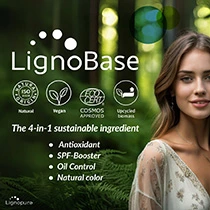Biodegradable beauty: Swapping synthetics for environmentally friendly ingredients

Biodegradable cosmetics emerge as a solution to changing and stricter regulations, forcing the industry to adapt. Commonly used beauty ingredients are leaving an environmental footprint, and while consumers do not want to trade off on performance, they seek planet-friendly products.
Personal Care Insights speaks with Marty Boykin, Eastman’s technology director, about the future of biodegradable ingredients, what is most sought after, and what ingredients to prioritize when going biodegradable.
“Our market research shows consumers are ready for biodegradable beauty solutions, but are not willing to compromise on performance. Biodegradable ingredients are the next step forward in meeting regulatory and consumer demands for safer and more sustainable products that brands are eager to deliver,” says Boykin.
He adds that one major trend is reducing intentionally added microplastics — like microbeads — in personal care products.
“However, it’s clear from consumer surveys and recent brand discussions that sustainability attributes are not enough. Consumers still expect their cosmetic products to maintain high-quality performance, such as providing soft focus, long wear, good coverage, and color payoff.”
He stresses that sustainable alternatives must offer similar or better performance to traditional ingredients to meaningfully drive consumer preference.
We also speak with Sandra Mota, co-author of a recent study investigating cork’s potential for cosmetics and PhD student at the University of Porto, Portugal. She observes that using biodegradable ingredients in the personal care industry is shifting from a niche trend to an industry standard.
“Driven by stronger environmental regulations, consumer demand for more sustainable products, and environmental goals, companies are increasingly investing in greener approaches for cosmetic ingredients,” says Mota.
“Over the past decade, we have witnessed significant progress in this area, including bans on certain non-biodegradable ingredients like microplastics and persistent UV filters, the development of green certifications and labels, and the first generation of biodegradable molecules.”
 The industry, planet, and consumers are benefiting from biodegradable ingredients.Benefiting health and planet
The industry, planet, and consumers are benefiting from biodegradable ingredients.Benefiting health and planet
Consumers are becoming increasingly conscious of the environment, and cosmetics are no exception. Mota says that everyone benefits from biodegradable beauty choices.
“For consumers, biodegradable beauty products offer reassurance that their skin care routines do not come at the expense of environmental health. For the industry, prioritizing biodegradability contributes to innovation, strengthens brand loyalty, responds to rising consumer demands, and ensures compliance with increasingly strict environmental regulations,” she says.
Mota explains that biodegradable cosmetic ingredients may also offer health benefits by replacing synthetic UV filters, which are known for their persistence in the environment and potential endocrine-disrupting effects. “Swapping them with biodegradable, mineral-based, or nature-inspired alternatives can benefit human health and the environment.”
She adds that transitioning from conventional synthetic fragrances, which are often persistent and bioaccumulative, to biodegradable alternatives can help minimize the risks of skin sensitization and reduce overall environmental hazards.
“For the planet, the shift toward biodegradable ingredients reduces the accumulation of persistent chemicals in water, soil, and ecosystems, helping to protect natural resources and safeguard clean water supplies, which are critical,” says Mota.
Demand for biodegradable microbeads
A previous common ingredient used in personal care products was synthetic microbeads, which both Boykin and Mota mention as the most popular biodegradable ingredient.
 Boykin stresses that consumers will not trade off on performance.Boykin says cosmetic products use various ingredients to create the look and feel consumers expect, such as smooth texture, a soft finish, or a natural glow.
Boykin stresses that consumers will not trade off on performance.Boykin says cosmetic products use various ingredients to create the look and feel consumers expect, such as smooth texture, a soft finish, or a natural glow.
“These ingredients can be synthetic or naturally derived. In the past, synthetic microbeads made from materials like nylon or plastic were commonly used to improve texture and coverage. Recently, natural and naturally derived powders such as silica and cellulose have become popular sustainable alternatives to synthetic ingredients,” he says.
However, these options have sometimes led to tradeoffs in performance and stability in specific cosmetic formulas, stresses Boykin. “To help address these challenges, Eastman developed Esmeri, a cellulose ester-based micropowder ingredient that offers improved performance, biodegrades, and is compatible with a wide range of color cosmetic formulations.”
Esmeri CC1N10 is a non-nano, readily biodegradable cellulose ester micropowder ingredient for various color cosmetic applications. Made from sustainably sourced wood pulp, it helps brands meet their sustainability goals while still delivering the expected performance.
Mota adds that plastic microbeads have already been banned in some countries. She adds that UV filters, preservatives, fragrances, and some antioxidants and polymers are critical for going biodegradable.
“These ingredients are widely used in cosmetic products and have significant environmental release after rinse-off or disposal. Ensuring these ingredients are readily biodegradable is key to lowering the overall environmental footprint of cosmetic products and contributing to the environmental sustainability of this sector,” says Mota.
She adds that innovative ingredients based on peptides and plant-derived polymers show great promise, due to their high performance while ensuring rapid environmental degradation after use.
 Due to regulatory pressures, there is a broader industry shift toward biodegradability and sustainably sourced materials.Regulations and research
Due to regulatory pressures, there is a broader industry shift toward biodegradability and sustainably sourced materials.Regulations and research
Boykin underscores that regulatory pressures are driving a broader industry shift toward biodegradability and sustainably sourced materials.
“In October 2023, Regulation (EU) 2023/2055 came into force, restricting the use of synthetic polymer microparticles (microplastics) in products placed on the EU market. This regulation implements measures to reduce environmental microplastic pollution,” he says.
Eastman recently conducted market research, surveying 4,000 women aged 16–70 in the US, UK, Brazil, France, and Germany. It showed that 75% of US and 74% of European consumers are interested in purchasing color cosmetics containing biodegradable microbeads.
Meanwhile, 90% of US and 89% of European consumers would try a brand they’ve never used before to buy products containing biodegradable microbeads. Eastman adds that 68% of participants in the US and 69% in Europe are also willing to pay more for color cosmetics that contain biodegradable microbeads.












